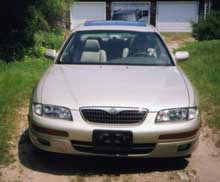For more than thirty years the Fosters have driven old cars, exclusively. At one time we’d buy well-kept 16 or 17-year-old vehicles. These days we like our creature comforts and a bit of luxury so the cars are some eight years old when they come to us, with about 100,000 miles. I’m fond of saying we put on the second hundred thousand.
And so it was when Jill’s 230,000 mile Peugeot shredded its driveshaft in June of 2005 we went looking for its successor. After driving a Saab and a Suburu, both of which were atrocious, we happened upon an eight-year-old Mazda Millenia with 106,000 miles. She made a deal and bought it.
The Millenia, you may remember, was designed to launch Mazda’s luxury brand Amati, to challenge Acura, Infiniti and Lexus. By the time it was ready, however, Mazda had decided that a new dealer network would be too costly, so the car was rebadged to sell as a Mazda, effectively replacing the 929 as the flagship model.
Introduced in the summer of 1994 as ’95 model, the oddly-spelled Millenia targeted Acura’s Legend, the Infiniti J30 and Lexus ES300. Priced $6,000 below the cheapest of them it seemed an incredible bargain, loaded as it was with heated leather and mirrors, traction control and a power-tilt steering wheel (with memory). For an extra six grand you could get a supercharged and intercooled Miller-cycle 2.3 liter V6, the first such powerplant on the US market, The base engine was Mazda’s four-valve normally-aspirated KL-ZE 2.5 liter V6, used also in the 626, MX-6 and Ford Probe.
Best of all, both Jill and I found it very attractive, commodious and comfortable. The roof worshiped both sun and moon, and the heated seats would roast your buns off. One thing the Millenia didn’t do was sell lots of cars. While Lexus sold about 40,000 ES300s, and the Acura and Infiniti equivalents about half that, Millenia sales were underwhelming. Thus, its resale value at eight years old was pretty puny. We drove away with what seemed like an incredibly good deal.
To be sure, the car soon needed repairs, struts front and rear and two new tires. Since we had no service history it also got a new timing belt and water pump, just in case. I soon tired of driving it. Handling was so-so and the 2.5 liter engine proved a bit puny for the 3,200-pound car. Jill liked it, but found the rearward visibility entirely unsatisfactory for someone of her height.
Ten thousand miles later, however, the new tensioner for the new timing belt let go. Fortunately we got it into the shop before any lasting damage was done. The Millenia engine is an “interference” design. When it’s working properly it doesn’t interfere with anything, but if it should lose time or break a timing belt the four camshafts will send the 24 tiny valves crashing into the pistons. For an older car, repair will cost more than the vehicle is worth.
Two weeks ago, Jill came home from a business trip. It was 1:00 AM and pouring with rain. She’d lost her cell phone at the airport. She put the car away and told me it had suddenly lost power about five miles from home, so she limped it on to her destination. The next day I tried to diagnose the malady. As soon as I started it up, I heard heavy metal. Somehow or other it had jumped time and the engine was running interference. We didn’t figure out exactly what had failed, and by that time it didn’t matter.
Some you win, some you lose. The car gave us 3-1/2 years, though barely 22,000 miles. On the grand scale of things, it was probably not a bad investment – the depreciation alone on a new car would have dwarfed our outlay over the same period. Still, it was a hard pill to take $200 from the dismantler (they’ve gone upscale – their license plates used to read “JUNK”) and watch the car being hooked up and towed away.
There’s a bright side. Its replacement was already being planned. Jill just has to wait a month until it’s ready.

